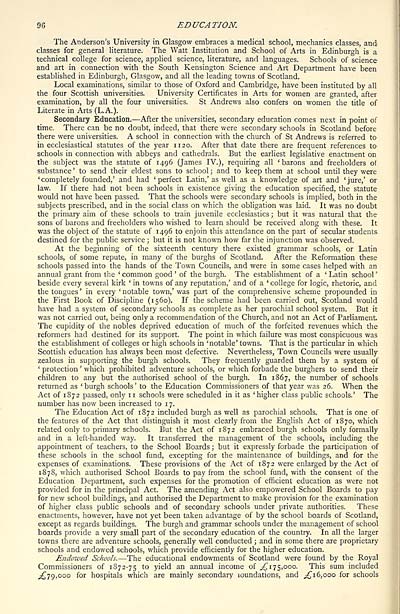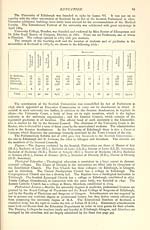Ordnance gazetteer of Scotland > Volume 6
(424) Page 96
Download files
Complete book:
Individual page:
Thumbnail gallery: Grid view | List view

96 EDUCATION.
The Anderson's University in Glasgow embraces a medical school, mechanics classes, and
classes for general literature. The Watt Institution and School of Arts in Edinburgh is a
technical college for science, applied science, literature, and languages. Schools of science
and art in connection with the South Kensington Science and Art Department have been
established in Edinburgh, Glasgow, and all the leading towns of Scotland.
Local examinations, similar to those of Oxford and Cambridge, have been instituted by all
the four Scottish universities. University Certificates in Arts for women are granted, after
examination, by all the four universities. St Andrews also confers on women the title of
Literate in Arts (L.A.).
Secondary Education. — After the universities, secondary education comes next in point of
time. There can be no doubt, indeed, that there were secondary schools in Scotland before
there were universities. A school in connection with the church of St Andrews is referred to
in ecclesiastical statutes of the year 1120. After that date there are frequent references to
schools in connection with abbeys and cathedrals. But the earliest legislative enactment on
the subject was the statute of 1496 (James IV.), requiring all 'barons and freeholders of
substance' to send their eldest sons to school; and to keep them at school until they were
'completely founded,' and had 'perfect Latin,' as well as a knowledge of art and 'jure,' or
law. If there had not been schools in existence giving the education specified, the statute
would not have been passed. That the schools were secondary schools is implied, both in the
subjects prescribed, and in the social class on which the obligation was laid. It was no doubt
the primary aim of these schools to train juvenile ecclesiastics; but it was natural that the
sons of barons and freeholders who wished to learn should be received along with these. It
was the object of the statute of 1496 to enjoin this attendance on the part of secular students
destined for the public service ; but it is not known how far the injunction was observed.
At the beginning of the sixteenth century there existed grammar schools, or Latin
schools, of some repute, in many of the burghs of Scotland. After the Reformation these
schools passed into the hands of the Town Councils, and were in some cases helped with an
annual grant from the ' common good ' of the burgh. The establishment of a ' Latin school '
beside every several kirk ' in towns of any reputation,' and of a 'college for logic, rhetoric, and
the tongues' in every 'notable town,' was part of the comprehensive scheme propounded in
the First Book of Discipline (1560). If the scheme had been carried out, Scotland would
have had a system of secondary schools as complete as her parochial school system. But it
was not carried out, being only a recommendation of the Church, and not an Act of Parliament.
The cupidity of the nobles deprived education of much of the forfeited revenues which the
reformers had destined for its support. The point in which failure was most conspicuous was
the establishment of colleges or high schools in 'notable' towns. That is the particular in which
Scottish education has always been most defective. Nevertheless, Town Councils were usually
zealous in supporting the burgh schools. They frequently guarded them by a system of
' protection ' which prohibited adventure schools, or which forbade the burghers to send their
children to any but the authorised school of the burgh. In 1867, the number of schools
returned as ' burgh schools ' to the Education Commissioners of that year was 26. When the
Act of 1872 passed, only n schools were scheduled in it as 'higher class public schools.' The
number has now been increased to 17.
The Education Act of 1872 included burgh as well as parochial schools. That is one of
the features of the Act that distinguish it most clearly from the English Act of 1870, which
related only to primary schools. But the Act of 1872 embraced burgh schools only formally
and in a left-handed way. It transferred the management of the schools, including the
appointment of teachers, to the School Boards ; but it expressly forbade the participation of
these schools in the school fund, excepting for the maintenance of buildings, and for the
expenses of examinations. These provisions of the Act of 1872 were enlarged by the Act of
1878, which authorised School Boards to pay from the school fund, with the consent of the
Education Department, such expenses for the promotion of efficient education as were not
provided for in the principal Act. The amending Act also empowered School Boards to pay
for new school buildings, and authorised the Department to make provision for the examination
of higher class public schools and of secondary schools under private authorities. These
enactments, however, have not yet been taken advantage of by the school boards of Scotland,
except as regards buildings. The burgh and grammar schools under the management of school
boards provide a very small part of the secondary education of the country. In all the larger
towns there are adventure schools, generally well conducted ; and in some there are proprietary
schools and endowed schools, which provide efficiently for the higher education.
Endowed Schools. — The educational endowments of Scotland were found by the Royal
Commissioners of 1872-75 to yield an annual income of £175,000. This sum included
,£79,000 for hospitals which are mainly secondary loundations, and ,£16,000 for schools
The Anderson's University in Glasgow embraces a medical school, mechanics classes, and
classes for general literature. The Watt Institution and School of Arts in Edinburgh is a
technical college for science, applied science, literature, and languages. Schools of science
and art in connection with the South Kensington Science and Art Department have been
established in Edinburgh, Glasgow, and all the leading towns of Scotland.
Local examinations, similar to those of Oxford and Cambridge, have been instituted by all
the four Scottish universities. University Certificates in Arts for women are granted, after
examination, by all the four universities. St Andrews also confers on women the title of
Literate in Arts (L.A.).
Secondary Education. — After the universities, secondary education comes next in point of
time. There can be no doubt, indeed, that there were secondary schools in Scotland before
there were universities. A school in connection with the church of St Andrews is referred to
in ecclesiastical statutes of the year 1120. After that date there are frequent references to
schools in connection with abbeys and cathedrals. But the earliest legislative enactment on
the subject was the statute of 1496 (James IV.), requiring all 'barons and freeholders of
substance' to send their eldest sons to school; and to keep them at school until they were
'completely founded,' and had 'perfect Latin,' as well as a knowledge of art and 'jure,' or
law. If there had not been schools in existence giving the education specified, the statute
would not have been passed. That the schools were secondary schools is implied, both in the
subjects prescribed, and in the social class on which the obligation was laid. It was no doubt
the primary aim of these schools to train juvenile ecclesiastics; but it was natural that the
sons of barons and freeholders who wished to learn should be received along with these. It
was the object of the statute of 1496 to enjoin this attendance on the part of secular students
destined for the public service ; but it is not known how far the injunction was observed.
At the beginning of the sixteenth century there existed grammar schools, or Latin
schools, of some repute, in many of the burghs of Scotland. After the Reformation these
schools passed into the hands of the Town Councils, and were in some cases helped with an
annual grant from the ' common good ' of the burgh. The establishment of a ' Latin school '
beside every several kirk ' in towns of any reputation,' and of a 'college for logic, rhetoric, and
the tongues' in every 'notable town,' was part of the comprehensive scheme propounded in
the First Book of Discipline (1560). If the scheme had been carried out, Scotland would
have had a system of secondary schools as complete as her parochial school system. But it
was not carried out, being only a recommendation of the Church, and not an Act of Parliament.
The cupidity of the nobles deprived education of much of the forfeited revenues which the
reformers had destined for its support. The point in which failure was most conspicuous was
the establishment of colleges or high schools in 'notable' towns. That is the particular in which
Scottish education has always been most defective. Nevertheless, Town Councils were usually
zealous in supporting the burgh schools. They frequently guarded them by a system of
' protection ' which prohibited adventure schools, or which forbade the burghers to send their
children to any but the authorised school of the burgh. In 1867, the number of schools
returned as ' burgh schools ' to the Education Commissioners of that year was 26. When the
Act of 1872 passed, only n schools were scheduled in it as 'higher class public schools.' The
number has now been increased to 17.
The Education Act of 1872 included burgh as well as parochial schools. That is one of
the features of the Act that distinguish it most clearly from the English Act of 1870, which
related only to primary schools. But the Act of 1872 embraced burgh schools only formally
and in a left-handed way. It transferred the management of the schools, including the
appointment of teachers, to the School Boards ; but it expressly forbade the participation of
these schools in the school fund, excepting for the maintenance of buildings, and for the
expenses of examinations. These provisions of the Act of 1872 were enlarged by the Act of
1878, which authorised School Boards to pay from the school fund, with the consent of the
Education Department, such expenses for the promotion of efficient education as were not
provided for in the principal Act. The amending Act also empowered School Boards to pay
for new school buildings, and authorised the Department to make provision for the examination
of higher class public schools and of secondary schools under private authorities. These
enactments, however, have not yet been taken advantage of by the school boards of Scotland,
except as regards buildings. The burgh and grammar schools under the management of school
boards provide a very small part of the secondary education of the country. In all the larger
towns there are adventure schools, generally well conducted ; and in some there are proprietary
schools and endowed schools, which provide efficiently for the higher education.
Endowed Schools. — The educational endowments of Scotland were found by the Royal
Commissioners of 1872-75 to yield an annual income of £175,000. This sum included
,£79,000 for hospitals which are mainly secondary loundations, and ,£16,000 for schools
Set display mode to: Large image | Transcription
Images and transcriptions on this page, including medium image downloads, may be used under the Creative Commons Attribution 4.0 International Licence unless otherwise stated. ![]()
| Gazetteers of Scotland, 1803-1901 > Ordnance gazetteer of Scotland > Volume 6 > (424) Page 96 |
|---|
| Permanent URL | https://digital.nls.uk/97392690 |
|---|
| Attribution and copyright: |
|
|---|---|

